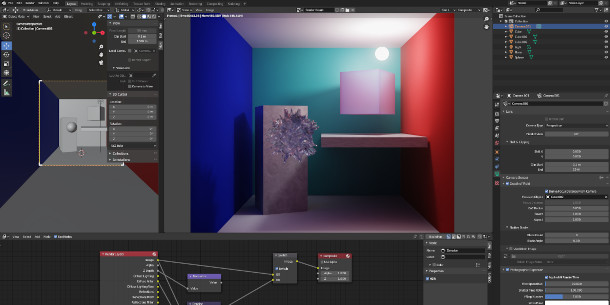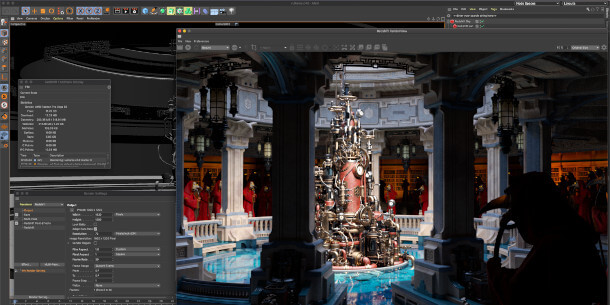Maxon releases Redshift for Blender and Metal in beta

Maxon has released the first public beta builds of both the new Blender integration plugin for Redshift, its GPU production renderer, and for the new Metal-native version of Redshift for current Macs.
Both open betas are available with Redshift 3.0.33, the latest version of the software.
New Blender integration plugin makes it possible to use Redshift with the open-source 3D software
Announced earlier this year, the long-awaited Blender integration plugin makes it possible to use Redshift natively with the open-source 3D software.
The integration uses Blender’s Python API, and features “pretty much identical” render options to those of the other 3D applications Redshift supports, although it’s still very much a work in progress.
Features not currently supported include proxies, texture baking, light linking, point clouds, motion blur and denoising using Redshift’s OptiX and Altus denoisers.
In addition, there is only “basic” support for AOVs – neither Cryptomatte ID matte generation or DeepEXR export is currently available – and only the perspective and orthogonal cameras are supported.
The integration is also currently only avaiable on Windows and Linux, although Maxon comments in the release thread on its forum that work on a macOS edition will start “hopefully soon”.

Long-awaited Metal version of Redshift works with AMD GPUs in new Macs
There is better news for Mac users running Cinema 4D, Houdini or Maya, with the release of the new Metal-native edition of Redshift in open beta.
Originally announced at Apple’s Worldwide Developer Conference last year, the port from Nvidia’s CUDA to Apple’s Metal as a GPU computing API will enable Redshift to run properly on current Mac workstations.
Apple no longer supports Nvidia cards, even as eGPUs, and in any case, CUDA no longer supports macOS.
The new open beta requires macOS 11.0 Big Sur, released publicly last week; and either an AMD Navi or Vega GPU, AMD’s current- and next-generation graphics cards.
That means a machine less than three years old: Navi GPUs first became available in Mac desktops in late 2017 with the iMac Pro, reaching Mac laptops the following year.
Maxon says that it is “working with Apple and AMD” to determine whether AMD’s older Polaris GPUs can be supported in future with “reasonable performance”.
Also new in Redshift 3.0.33: better render denoising, extended support for Houdini
Other changes in Redshift 3.0.33 include support for Object Trace Sets and for portal and mesh lights when running Redshift as a Hydra render delegate within Houdini.
All users can now perform temporal denoising using the Altus denoiser from the command line.
The Redshift 3.0 releases have gone from experimental builds to (semi-)official production versions.
While not all of the features originally planned for the 3.0 release series have yet been implemented, Redshift 3.0.33 can now be downloaded directly from the product website, alongside Redshift 2.6.56.
Pricing and system requirements
The new Blender integration plugin and Metal edition of Redshift are available with Redshift 3.0.33. Both are currently still in beta.
Redshift 3.0.33 is available for 64-bit Windows 7+, glibc 2.17+ Linux and macOS 10.12-10.13 on Nvidia GPUs, or macOS 11.0 on AMD GPUs. It costs $500 for a node-locked licence; $600 for a floating licence.
The integration plugins are compatible with 3ds Max 2014+, Blender 2.90, Cinema 4D R17+, Houdini 17.0+ (18.0+ on macOS), Katana 3.0v1+ and Maya 2014+ (2016.5+ on macOS).
By Jim Thacker/CG Channel

熱門頭條新聞
- Revolutionizing Legal Work: How Robin AI Accelerates Contract Review
- TyFlow brings Stable Diffusion AI directly into 3ds Max
- Gamescom 2024
- TRANSFORMERS: GALACTIC TRIALS HEADS TO CONSOLES AND PC THIS OCTOBER
- STAKE YOUR CLAIM IN KINGDOM, DUNGEON, AND HERO OUT NOW ON STEAM
- MBC’s Shahid platform announces premiere of ‘Grendizer U’
- Award-Winning Studio Secures 6 Million SEK in Investment
- FARMING SIMULATOR 25 AT FARMCON: GIANTS SOFTWARE ANNOUNCES PRE-STREAM & STAGE SCHEDULE
